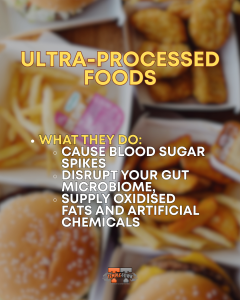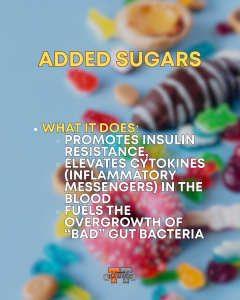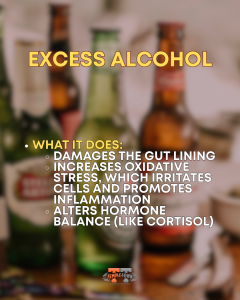Back Pain & Food: The Nutrition Fix You Didn’t Know You Needed
If you’ve been battling persistent lower back pain, you’ve likely explored every avenue: dedicated stretches, targeted core work, regular physio sessions, perhaps even investing in a brand-new mattress. You’re committed to finding a solution.
But what if a significant piece of the puzzle is sitting right there on your plate?
Most people don’t connect their chronic lower back discomfort to their dietary habits. Yet growing evidence points to chronic, low-grade inflammation, frequently driven by poor nutrition, as one of the biggest hidden contributors to persistent stiffness, soreness, and those frustrating flare-ups that seem to come from nowhere.
And if you’re like many of my clients, over 30, spending significant time seated, pushing hard in the gym a few times a week – your body is already under considerable stress. Add inflammatory foods to the mix, and you’re essentially driving with the handbrake on.
Let’s change that.
🔥The Missing Link: Why Your Food Affects Your Back
Think of food like a volume dial for pain. Some foods help turn the signals down. Others crank them right up.
Here’s what’s happening: chronic low-grade inflammation doesn’t just make you feel generally achy. It directly impacts your nervous system, delays tissue recovery, and keeps pain signals firing even when your body should be healing.
Your daily food choices are actively contributing to, or fighting against the inflammatory environment in your body. Your plate isn’t just fuel for energy; it’s either medicine for recovery or fuel for persistent pain.
A Real Client Example
I had a client recently who was doing everything right on paper. Smart training. Consistent mobility work. Great discipline. Yet he still woke up stiff and sore most days.
When we looked at his nutrition, the pattern was clear: weekends dominated by alcohol, takeaways, crisps and sugary treats. A consistent inflammatory load that his body couldn’t recover from. Once we addressed those patterns with simple, sustainable swaps, his back flare-ups dropped by over 60% in four weeks. It was the missing piece he’d been searching for.
🚩 The 4 Biggest Inflammatory Culprits
This isn’t about shame or perfection – it’s about awareness. If these are regular staples in your diet, they could be sabotaging your recovery:

1. Ultra-Processed Foods
Examples: Microwave meals, packaged snacks, most takeaways, sugary cereals
The Problem: Loaded with inflammatory oils, refined sugars, and additives that trigger systemic inflammation and burden your recovery systems.
The Problem: Loaded with inflammatory oils, refined sugars, and additives that trigger systemic inflammation and burden your recovery systems.

2. Refined Sugars
Examples: Sweets, fizzy drinks, desserts, plus sneaky sources like ketchup, sweet chilli sauce, and breakfast cereals
The Problem: Blood sugar spikes create an inflammatory cascade, contributing to cellular stress and heightened pain sensitivity.
The Problem: Blood sugar spikes create an inflammatory cascade, contributing to cellular stress and heightened pain sensitivity.

3. Unbalanced Fats
Examples: Sunflower oil, corn oil, cheap oils in takeaways and processed foods
The Problem: Sky-high in omega-6s while most people are deficient in omega-3s. This imbalance directly promotes inflammation and turns up that pain volume dial.
The Problem: Sky-high in omega-6s while most people are deficient in omega-3s. This imbalance directly promotes inflammation and turns up that pain volume dial.

4. Excess Alcohol
The Problem: Regular drinking impacts liver function, disrupts hormones and adds to your body’s inflammatory burden, delaying recovery and potentially worsening existing pain.
Important: You don’t need to eliminate everything. But if 80% of your food choices are fuelling inflammation, your body’s healing systems never get a chance to catch up.
✅ 3 Simple Fixes You Can Start This Week
No need to become a nutritionist overnight. These three evidence-based changes are highly effective for back pain, especially when combined with smart training:
Fix 1: Eat Colour First
What to do: Build meals around whole foods – lean proteins, colourful vegetables, fruits, quality carbs.
Why it works: These foods are nature’s pharmacy, packed with anti-inflammatory compounds that support cellular repair. Aim for 5-7 portions of fruit and veg daily.
You don’t need exotic superfoods, just real food that looks like it came from the ground, a tree, or an animal.
What to do: Build meals around whole foods – lean proteins, colourful vegetables, fruits, quality carbs.
Why it works: These foods are nature’s pharmacy, packed with anti-inflammatory compounds that support cellular repair. Aim for 5-7 portions of fruit and veg daily.
You don’t need exotic superfoods, just real food that looks like it came from the ground, a tree, or an animal.
Fix 2: Balance Your Fats
What to do: Get more omega-3s into your week. Oily fish like salmon, sardines, or mackerel 2-3 times weekly. Don’t like fish? Get a high-quality fish oil supplement. Add chia seeds, flaxseeds, or walnuts for extra support.
Why it works: Omega-3s are powerful anti-inflammatory agents that counteract the pro-inflammatory effects of excess omega-6s. This single change can massively accelerate your healing.
What to do: Get more omega-3s into your week. Oily fish like salmon, sardines, or mackerel 2-3 times weekly. Don’t like fish? Get a high-quality fish oil supplement. Add chia seeds, flaxseeds, or walnuts for extra support.
Why it works: Omega-3s are powerful anti-inflammatory agents that counteract the pro-inflammatory effects of excess omega-6s. This single change can massively accelerate your healing.
Fix 3: Hydrate Like You Mean It
What to do: Aim for 2-3 litres of water daily, more if you’re training hard. Carry a bottle and sip consistently throughout the day.
Why it works: Your spinal discs act like sponges – they need water to stay springy and absorb shock. Dehydration contributes to stiffness and impairs healing. Proper hydration speeds recovery and supports joint health.
What to do: Aim for 2-3 litres of water daily, more if you’re training hard. Carry a bottle and sip consistently throughout the day.
Why it works: Your spinal discs act like sponges – they need water to stay springy and absorb shock. Dehydration contributes to stiffness and impairs healing. Proper hydration speeds recovery and supports joint health.
🎯 The Bottom Line: Food as Medicine
You’re already training smart and dedicating time to movement. Now it’s time to fuel smarter. When managed consistently, the right nutrition helps:
- Reduce persistent stiffness and soreness
- Shorten recovery time between sessions
- Improve energy and functional mobility
- Build long-term resilience from the inside out
None of these fixes are fancy. But done consistently, they change how your back feels.
You’re not broken – you’re just missing part of the picture. And nutrition is the piece most people ignore.
🎧 Hear This in Action: Episode 5 Now Live
Want to dive deeper into this topic? I break down everything above, plus share more client stories and practical tips in Episode 5 of The Lower Back Pain Podcast That Actually Helps.
Listen now:
Coming Next Week: We’re talking about the nervous system – why pain isn’t always about damage and how your brain can keep pain switched on even after your body’s healed. It’s a big one.
💬 Ready for a Personalised Plan?
Training hard but still feeling stuck in cycles of pain and stiffness? Let’s fix that missing piece. I help people like you rebuild strength, optimise core function, and align nutrition into a system that works with your life, not against it.
Training hard but still feeling stuck in cycles of pain and stiffness? Let’s fix that missing piece. I help people like you rebuild strength, optimise core function, and align nutrition into a system that works with your life, not against it.
Get in touch:
- 📲 Instagram: @TempletownStrengthConditioning
- 📧 Email: info@templetownsc.com
Let’s build a plan to get you stronger, moving freely, and living without constant back pain.
Train smarter, not broken.
– Paul
– Paul

